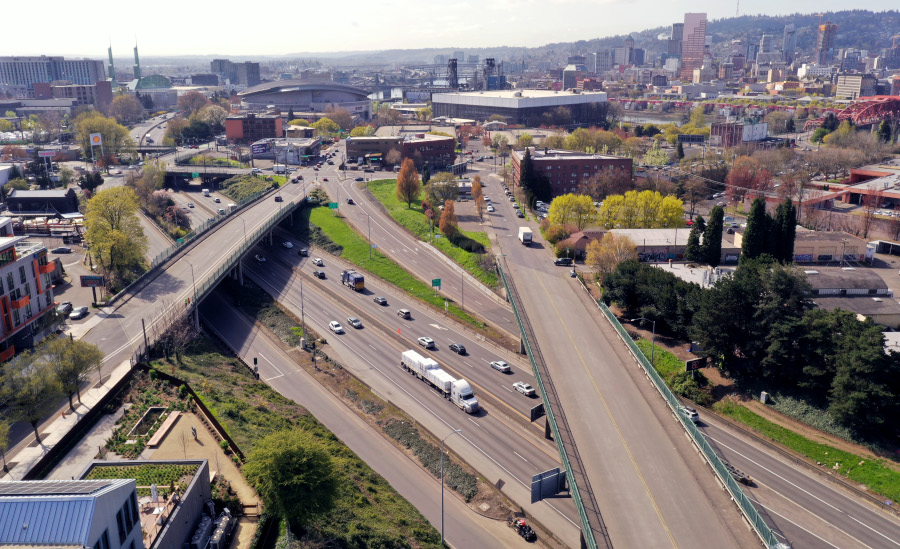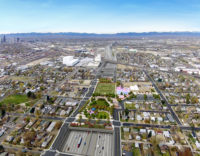The I-5 Rose Quarter Improvement Project in Portland, Ore., clinched a $450-million federal grant and secured critical environmental review approval this week, propelling the long-awaited project forward.
The Oregon Dept. of Transportation (ODOT) and City of Portland project will add auxiliary lanes to Interstate 5 and construct a highway cover to support reconnection of the city’s Albina community to the city's downtown. In the 1950s and 1960s, the I-5 freeway was constructed through the heart of the community, removing hundreds of predominately Black-owned homes. The interstate also separated the Albina neighborhood from the Willamette River and downtown Portland.
The funding comes from a U.S. Dept. of Transportation (USDOT) Reconnecting Neighborhoods and Communities Grant. A Finding of No Significant Impact (FONSI) for of environmental review approval from the Federal Highway Administration (FWHA) will allow ODOT to move forward with more detailed project design.
“This federal environmental decision paired with substantial funding highlights the alignment of supporters who want to see this project built,” Megan Channell, ODOT project director, says in a statement.
The project now includes a single, more substantial highway cover expected to support development. It is meant to reconnect and improve local street access and add pedestrian, bicycle and ADA facilities, including a dedicated pedestrian/bike-only bridge over the interstate that runs through downtown Portland.
Portland also received an additional Reconnecting Neighborhoods and Communities Grant of $38 million for the Broadway as a Main Street Project, an effort that complements and extends the planned investments to the Rose Quarter.
The project now has the backing of 15 partners at the federal, state, regional, local and community levels, including the Albina Vision Trust, a non-profit neighborhood advocacy group.
“The I-5 Rose Quarter Project has come a long way,” Millicent Williams, Portland Bureau of Transportation director, says in a statement. “Thanks to the deep involvement of local community stakeholders serving on the Historic Albina Advisory Board, the leadership of the Albina Vision Trust and the work of PBOT staff, this project has gone from exacerbating past harms to an effort that can help repair and restore a community.”
The I-5 Rose Quarter project includes five highway "caps" to restore street-level access between the Albina neighborhood and downtown.
Rendering courtesy USDOT
Improvements to the I-5 mainline highway will feature wider shoulders to support faster emergency response times. The plan will construct auxiliary lanes to improve traffic flow, relocate the southbound off-ramp from Vancouver/Broadway to the south near the Moda Center to support redevelopment opportunities and construct a flyover structure to direct 60% of I-5 off-ramp traffic headed east of I-5 away from the Rose Quarter district.
“This federal investment,” Williams says, “will help Portland restore and revitalize what was once the largest, most vibrant Black neighborhood in Oregon.”
The design process for the project began in 2017 and originally included two smaller highway covers. That design did not have full community support, leading ODOT to create the Historic Albina Advisory Board made up of Black community leaders. Public workshops, online open houses, surveys and meetings led to the single highway cover design able to support buildings. The latest design received environmental approval from the FHWA.
The $450 million grant will go toward completing the design and constructing the core part of the highway cover.
“This catalytic federal investment represents the beginning of a new chapter, one where government plays an active role in not only healing the harms of history but investing in community-driven visions of a better tomorrow,” Winta Yohannes, Albina Vision Trust executive director, says in a statement. The trust and advisory board call the grant and project more than just funding for a project, but a step toward rebuilding Albina.
The I-5 Rose Quarter Improvement Project aims to reconnect the neighborhood, but also address an intense traffic bottleneck where interstates 5, 405 and 84 all converge at the Rose Quarter, forcing traffic down to two lanes. The area is the worst traffic bottleneck in the state and has 12 hours of congestion each day. The rapid merging slows traffic and leads to 3.5 times more crashes than the average Oregon location.
The auxiliary lanes can help move travelers from one interstate to another without merging into through traffic.




Post a comment to this article
Report Abusive Comment